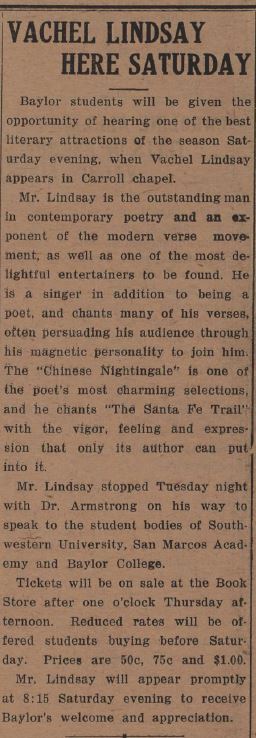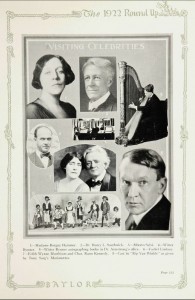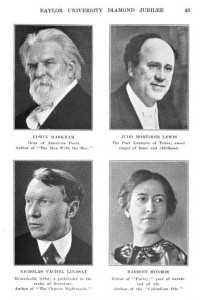“Armstrong’s Stars” is a collaboration between the Armstrong Browning Library and Baylor’s Texas Collection. Once a month we feature a story about a celebrity that Dr. A.J. Armstrong brought to Baylor. These stories highlight an interesting part of Baylor’s history and include collection materials housed in both the Armstrong Browning Library and the Texas Collection.
This month’s story was contributed by Baylor graduate (BA ’14) and Sigma Tau Delta member Susie Park.

March 27, 1919, issue of The Lariat announcing Vachel Lindsay’s upcoming visit to Baylor (Texas Collection)
One of the most memorable scenes from the movie Dead Poets Society captures the musical aesthetics of American poet Vachel Lindsay’s style of singing poetry. The cave scene of the schoolboys chanting Lindsay’s poem “The Congo” begins with one of them rhythmically reciting a few lines and escalates to all of the boys joining in by clapping, hissing, chanting along, hollering, and banging on drums to create a musical performance out of a written work of poetry. As described in the March 27, 1919, issue of Baylor’s student newspaper The Lariat, “[Vachel Lindsay] is a singer in addition to being a poet, and chants many of his verses, often persuading his audience through his magnetic personality to join him” (“Vachel Lindsay Here Saturday” 1).
Vachel Lindsay made several appearances at Baylor University at the invitation of Dr. A.J. Armstrong. His first major public appearance at Baylor was on March 29, 1919. Interestingly, an article from The Lariat, dated March 13, 1919, specifically notes that Lindsay is scheduled to visit on March 28, but a later article from March 27 states that Lindsay will visit on March 29 at 8:15 in the evening at Carroll Chapel (“Vachel Lindsay to Be in Baylor March 28” 1; “Vachel Lindsay Here Saturday” 1).
The April 3, 1919, issue of The Lariat includes details of Lindsay’s March 29 visit to Baylor, listing the poems that he recited as well as the students’ reactions to the poet. Lindsay read some of his poems, like “The Santa Fe Trail” and “The Chinese Nightingale,” and shared a series of interpretations of the works. The Lariat praises the poet’s unique style and his outlook on poetry. When discussing his style of reciting poetry, Lindsay is quoted as saying that the human voice “‘is the perfect instrument of musical expression, and with the twenty-six letters in the alphabet as keys upon which the human voice may play at will, true poetry is capable of being brought to its highest rhythmical perfection’” (“Vachel Lindsay Has Extended Visit to Baylor and Waco” 1).
After his eventful visit to Baylor in 1919, Lindsay announced that he would visit again on March 20, 1920. The Lariat article from February 19, 1920, notes the poet’s future visit to Baylor and that he has come out with a new volume of poems (“Vachel Lindsay to Be Here on March 20” 10).
The celebration of the seventy-fifth anniversary of Baylor University, or the Baylor University Diamond Jubilee in June 1920, brought together many celebrities, including Vachel Lindsay. Lindsay was one of the visiting poets who participated in “The Browning Benefit,” or “All Artists’ Benefit.” This program was a presentation event to showcase the “Clasped Hands,” an original bronze casting of the clasped hands of Robert and Elizabeth Barrett Browning that was being added to the Baylor Browning Collection. The other three visiting poets participating in this presentation ceremony included Edwin Markham, Judd Mortimer Lewis, and Harriet Monroe (Trantham 44).
An article in The Lariat, dated May 20, 1920, expresses the excitement surrounding the Diamond Jubilee, listing some of the distinguished guests to be present at the celebration: “Among the celebrated poets and writers who will honor Baylor in June will be William Butler Yeats, Vachel Lindsay, Edwin Markham, Amy Lowell, Dorothy Scarborough, and the poet laureate of Texas, Judd Mortimer Lewis” (“Distinguished Guests to Be Present at Diamond Jubilee” 6).

The 1922 issue of Baylor’s yearbook The Round Up highlighting celebrities who had visited Baylor (The Texas Collection)
“The death Saturday of Vachel Lindsay brought to a close a friendship of eighteen years between one of America’s greatest poets and Baylor University” (“Baylor Loses Friend as Lindsay Succumbs” 2). Vachel Lindsay passed away on December 5, 1931. The December 8, 1931 issue of The Lariat mentions the poet’s death, tracing back Lindsay’s close relationship with Dr. Armstrong. Lindsay supposedly planned to visit Baylor University again in the spring of 1932; Sigma Tau Delta wanted to present the poet to the Baylor student body. From his initial participation in Dr. Armstrong’s contemporary poetry class in 1913 to his planned visit in 1932, it is not an overstatement to say that Vachel Lindsay and the Baylor Browning Collection grew together in time.
Works Cited
“Baylor Loses Friend as Lindsay Succumbs.” The Daily Lariat 8 December 1931: 2. Web. 19 Feb. 2015.
“Distinguished Guests to Be Present at Diamond Jubilee.” The Lariat 20 May 1920: 6. Web. 18 Feb. 2015.
The Round-Up 1922. [Waco, Tex.: Baylor University, 1922]. Web. 19 Feb. 2015.
Trantham, Henry. The Diamond Jubilee, 1845-1920: A Record of the 75th Anniversary of the Founding of Baylor University. Waco, Tex.: Baylor University Press, 1921. Web. 19 Feb. 2015.
“Vachel Lindsay Has Extended Visit to Baylor and Waco.” The Lariat 3 April 1919: 1. Web. 18 Feb. 2015.
“Vachel Lindsay Here Saturday.” The Lariat 27 March 1919: 1. Web. 18 Feb. 2015.
“Vachel Lindsay to Be Here on March 20.” The Lariat 19 February 1920: 10. Web. 18 Feb. 2015.
“Vachel Lindsay to Be in Baylor March 28.” The Lariat 13 March 1919: 1. Web. 18 Feb. 2015.


Thanks for the post. Vachel Lindsay was one of my father’s favorites (and a testament to the power of Louis Untermeyer’s poetry anthologies). I grew up hearing the rhythms of “The Congo” and “General William Booth Enters Into Heaven,” plus the imagery of “Abraham Lincoln Walks At Midnight.” Nice to know Armstrong appreciated him, too.
Thanks so much for your comment, Carl!
Hi Jennifer,
I created and adapted a one man play that I perform from Vachel Lindsay’s writings about his walks across the country trading his poetry for food and lodging and distributing his “Gospel of Beauty”. I am performing it at the Chicago Fringe Festival this September 3, 5, and 7, 2015. I love the post here. It is nice to see people appreciate his visionary and courageous work.
Thanks for your comment, Steve! Your play sounds fascinating!